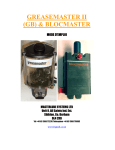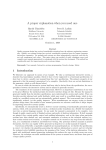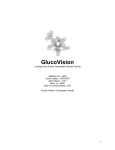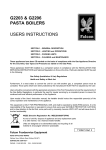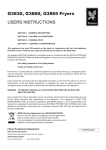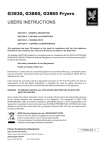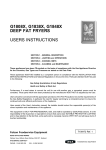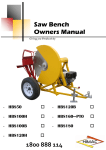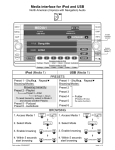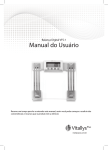Download among the model builders - Meccano Society of Scotland
Transcript
INDEX Spring . . . . . . . . . . . . . . . . . . . . . . . . . . . . 1 Minutes of meeting of 21 st January . . . . . . . . . . . . . 1 Minutes of meeting of 18th March . . . . . . . . . . . . . . 2 Meccano Street Racing Car Set Review . . . . . . . . . . . 4 An Unusual Request . . . . . . . . . . . . . . . . . . . . . 6 MotorVator – A Review . . . . . . . . . . . . . . . . . . . 8 The Menstrie Challenge . . . . . . . . . . . . . . . . . . . 12 Among the Model Builders . . . . . . . . . . . . . . . . . 13 Meccano on the Internet . . . . . . . . . . . . . . . . . . 16 DATES FOR YOUR DIARY Balado . . . . . . . . . . . . . . . . . . . . . . . . . . . . . . . . 12th/13th May Constructor’s Day . . . . . . . . . . . . . . . . . . . . . . . . . . . 19th May NEMS Exhibition at Shildon . . . . . . . . . . . . . . . . . . . . . 27th/28th May SkegEx . . . . . . . . . . . . . . . . . . . . . . . . . . . . . . . . 29th June/1stJuly Society meeting, Smith’s Museum, Stirling . . . . . . . . . . . . . 19th August Annual Exhibition, Scone . . . . . . . . . . . . . . . . . . . . . . 8th/9th September Society meeting, Smith’s Museum, Stirling . . . . . . . . . . . . . 18th November SPRING No, not tension or compression, the green shoots kind. Yes, it is here again and the gardening tools have to come out and outdoor pursuits of a more frivolous nature take over as the clock changes and the weather gets a little warmer. For Meccanomen (and ladies, one hastens to add – our female membership having tripled in the past year) the winter pastime of model building may well have to take a back seat as the season changes. However we do have a series of events to look forward to. The exhibition at Balado and the Menstrie Constructors Day are now only a few weeks away. Members are encouraged to do a small amount of (inventive?) model building for the latter – see The Menstrie Challenge later in this issue. This issue of the newsletter is atypical in that it contains no exhibition reports. This is a reflection of the time of year – all exhibitions that we attend are in the May – November period. What we do have are a series of articles by members of the Society either reviewing Meccano products or outlining solutions to various problems encountered when model building. The article in this latter vein will be, we hope, the first of an occasional series in the style of the “Among the Model Builders” series that used to appear in the Meccano Magazine. What we will need to make this a success is as many members as possible to write articles under this heading. They do not have to be long, pictures attached would be welcome but not necessary. Whatever you have built recently and whatever you build from now on, take note of the difficulties involved, document them, however briefly, along with an account of your way out of the problem and send the result to the editor. It would also be good to hear from people who do not encounter any problems. Their considerable expertise deserves a wider audience. * * * * * Club Meeting, 21 January 2007 The meeting was held as usual in the Smith Art Gallery and Museum, Stirling, at 2 pm. Members present were Jim Berrie, Philip Hore, Margaret Tattersfield, Angus Plumb, Douglas Carson, Bill Jack, Jim Wood, Gordon MacMillan, Dick Martin, Bob Middlemass, Mike Ridley, Jackie Inglis, Jim Gregory, Desmond Smith, Alan McDonald (Treasurer), Alan Blair, Alistair Nicoll (Newsletter Editor), Tim Edwards (Webmaster), and Bert Hutchings (Secretary). There were apologies from Martin Donoghue. Exhibitions: the Scottish Traction Engine Society has invited us to exhibit at Balado again this year, on 12 and 13 May. A sufficient number of members agreed that they would attend on the Saturday, the Sunday, or both days (Alan McDonald, Jim Berrie, Jackie Inglis, Alan Blair, Margaret Tattersfield, Douglas Carson, Dick Martin, and Bert Hutchings). We also look forward to our annual exhibition at Scone on 8 and 9 September, in conjunction with the “Farming Yesteryear” event of the Scottish Vintage Tractor and Engine Club, which Alan Blair is attending to the details of. He suggested that small models could be arranged on shelving to peciali the use of the available space, and urged members to contribute to this. For publicity, the Treasurer and Angus Plumb agreed to explore various ways of producing laminated copies of traditional Meccano posters and advertisements, up to A2 size if possible. Alistair Nicoll and Tim Edwards had collaborated on the rules for the competition at our Open 1 Day at Menstrie on 19 May. The rules were distributed and agreed. Treasurer: the Treasurer reported that 4 of last year’s members had not yet renewed their subscriptions, and that we had one new member, introduced by Jim Gregory. Newsletter: the Editor suggested the inclusion of a section similar to the “Among the ModelBuilders” feature found in older Meccano Magazines. The meeting was enthusiastic, although the feature will depend on contributions from members, and especially from competition winners. Website: the Webmaster had recently corrected the model builders’ names relating to last year’s Open Day, and also updated the site with pictures from Scone. Other business: the Secretary passed round an incomplete 1922 sawbench for members’ interest, since it is a relatively scarce item. Philip Hore had examples of the recent Marks and Spencer “Red Arrow” and “Vintage 1933” sets, which were interesting items but everybody agreed that the lack of any continuity in the range of these new sets still seemed like an unfortunate backward step. Jim Gregory showed us two small models of his own, and Jim Wood had two more built from the new sets. These were advertised as suitable for 8 years old and over, but Jim said that they had been quite tricky to assemble, although the Allen-head bolts helped quite a bit. Doug Carson had contributed to a friend’s fancy dress outfit with a watch, chain and fob all made from Meccano parts which were much admired. Gordon MacMillan showed us an East German “Eitech” construction set resembling Meccano in some respects but with the parts in metric sizes. Desmond Smith brought along a set from the new “Speed Play” range, and members were very interested in its combination of many new pecialized parts with a fair quantity of the traditional older parts. Mike Ridley had acquired a number of parts which he thought were Erector, and members familiar with the range confirmed this for him. Bert Hutchings, Secretary * * * * * Club Meeting, 18 March 2007 The meeting was held as usual in the Smith Art Gallery and Museum, Stirling, at 2 pm. Members present were Alan McDonald (Treasurer), Margaret Tattersfield, Angela Goodlet (new member), Desmond Smith, Jim Gregory, Jackie Inglis, Bill Jack, Douglas Carson, Angus Plumb, Dick Martin, Jim Berrie, Ken McDonald, Tim Edwards (Webmaster), and Bert Hutchings (Secretary). There were apologies from Gordon Macmillan. Exhibitions: the members exhibiting at Balado on 12-13 May all confirmed their plans to attend, and Ken McDonald offered to stand in for anybody who had to drop out. The Treasurer will arrange to have the banner brought on the Saturday, and the Secretary will bring some of our table covers. The North Midlands Meccano Guild’s annual exhibition at Skegness is on 2930 June and 1 July. Jim Gregory will host another exhibition at Auchterarder on 28 July, to raise funds for the “Amazon Hope” travelling health centre, and all members are welcome. 2 In Alan Blair’s absence, it was hoped that all the arrangements for Scone on 8-9 September were progressing well. Jim Berrie had brought a very large poster which Angus Plumb took away, expecting to be able to reproduce and laminate it, and the meeting agreed to the probable cost. He also selected a few smaller posters from a group which Tim Edwards had brought. Our thanks to all these members for this effort. Treasurer: the Treasurer reported that our insurance agent had been taken over, and the new larger owners had declined to continue our cover. Several members were quite concerned about any potential public liability claim. The Secretary will inquire about other clubs’ arrangements. Website: further competition pictures have been added. A few members suggested that there could be a section on the web site where visitors could record their comments about it, and the Webmaster agreed to investigate this. Other business: Angela Goodlet displayed a colourful catamaran, and a giant swingboat, both built mostly from the parts in the Ferris Wheel set. She hopes to add lighting to the swingboat. Jackie Inglis was able to warn members that the small single-model sets available in some branches of Boots were the same as the Marks and Spencer sets, but considerably dearer. Douglas Carson showed us a single-cylinder stationary engine made with parts from a wide range of periods, which he had bought very cheaply on eBay and completed by adding a small motor and sprocket drive. Future meetings: Open Day at Menstrie on 19 May, then 19 August and 18 November, both at Stirling. Bert Hutchings, Secretary * * * * * 3 THE MECCANO STREET RACING RC CAR SET REVIEW by Douglas Carson Urban RC Street Racing Car Touring Style RC The Meccano Street Racing RC (8950) car is one of three in the 2006 catalogue which collectively form the Tuning range of models. The others are the Urban RC (6950) and the Touring Style RC (8951). The three models are illustrated above. I was fortunate enough to receive my model for Christmas, so later that evening I retreated from the festivities to the model room to begin construction. The kit is well packaged in polystyrene inside a cardboard box and comprises 368 parts. Three different models can be built (one at a time) and I opted for the one illustrated above. The most significant part is the chassis which comes as a single part comprising chassis, wheels, front wheel steering, remote control (RC) receiver, servos and batteries, all (except the wheels) encased in black plastic. Accompanying this is the RC transmitter which is also illustrated above. The chassis is powered by six 1.5V batteries and the RC unit takes one 9V battery. The remote control operates on 27 MHz and only one frequency is provided so it is impossible to operated more than one vehicle in close proximity. I would have found it more enjoyable if it was necessary to construct at least some of the chassis, however the model is aimed at age eight and upwards so I assume that Meccano decided this would be just too much at that age. Having said that, I think an unaided eight year old would struggle with this model unless he or she had first built some of the smaller models in the current Meccano range and thereby learnt the general principles of the Meccano system. 4 The general idea is to construct the body of the vehicle and then attach this to the chassis. The roof is made of a single formed piece of black semi-transparent plastic so most of the construction effort is taken up by making the bonnet, wheel arches, wings, side panels and rear end assembly. The instructions are in the form of step by step diagrams and are well laid out and easy to follow. Being “new” Meccano, much use is made of flexible spring steel parts which allow the creation of curved surfaces in a way that would be very difficult in traditional Meccano. These can be a little fiddly to assemble at times as the curved parts are under tension at the point where they are joined by the nuts and bolts. On the subject of nuts and bolts, some of the bolts are finished in black rather than the usual bright “silver”. These are used against the black plates and strips to good effect. I was disappointed to find that six out of the 120 nuts were imperfectly tapped (an error rate of 5%) and had to be discarded. This was not a problem for me but if this was your first Meccano model it would be a real show stopper. I’ve not had this problem before with “new” Meccano, so perhaps I was just unlucky. The model boasts illuminated headlamps and tail lamps. This works by connecting lamps on the chassis to plastic lamp inserts on the body using lengths of solid clear plastic tube which gives an optical fibre effect. Somewhat to my surprise this arrangement works very well. The final stage is to attach the superstructure to the chassis and this was decidedly fiddly however with a little patience it was done. Hint: attach one side first and fix the rear connecting bolt before the front one on each side. When fully assembled, the model is approximately 11½ inches long by 5¾ inches wide at its widest point. Two sound effects are provided; engine noises and screeching wheels. Music of a sort is also provided with two tunes; hip-hop and rock. Which was which, I could not say! Personally, I could have done without the music but this is no doubt supposed to attract the youth market. Sound effects, music and lights can be used in several combinations or all turned off. One combination not provided is engine noises and lights on, but music off, which is the one I would have liked most. Several self-adhesive stickers are provided to give the model a “cool” look. I decided not to use all of these and restricted myself to the Meccano logo on the top of the windscreen. The car was now ready for its road test. On a hard floor the car certainly moves very quickly – perhaps slightly too quickly! The steering does not have a great lock but is adequate. Summary PLUS POINTS Attractive looking model with great curves Performs well on a hard surface MINUS POINTS Pre-formed chassis Six imperfectly tapped nuts Only one radio frequency provided Model bought at John Lewis in Glasgow; cost £40. 5 Illustrations © Meccano 2006 AN UNUSUAL REQUEST by Douglas Carson A friend of mine approached me recently with an unusual request. He explained that he was invited to a fancy dress party, the theme of which was children’s toys. Could I make him up some Meccano that he could wear? I agreed and we discussed what would be suitable for a rather “smart” party. My first thought was that “less is more” and I suggested some plates with attached strips and wheel discs that he could fix to his jacket. A week or too later I duly produced some items for his inspection. Whilst these were judged acceptable, I sensed that my friend was really looking for something rather more striking. Later that evening, fuelled by Islay malt whisky, I had my eureka moment. I would make a Meccano watch, chain and fob for my friend’s waistcoat! With two semi-circular plates, some short strips, some chain and something chunky at the other end, we would be in business. The Watch, Chain, and Fob The watch face is made of two semi-circular plates and the hands are a 1½” strip, a fishplate and a red modern 1½” narrow strip. These are mounted on a large washer and then a small washer in order that the hands clear the bolts on the edges of the semi-circular plates. The central 3/8” bolt is double nutted on the reverse to allow the hands to move stiffly. The fob is formed by bolting together two flat trunnions. 6 The back, showing detail of the chain attachment Attaching the chain to the watch and fob is perhaps the most interesting part. A 3/8” bolt is passed through a cord anchoring spring and double nutted to allow the spring to move freely. One hook at the end of the chain is passed through the loop of the anchoring spring and closed off. At the other end of the chain, the last loop is passed through the loop of the spring and again closed off securely. And there you have it; a smart piece of costume jewellery for the well dressed Meccano gentleman. Parts Listing 1 x 6a 1 x 10 11 x 37a 5 x 37b 1 x 38 1 x 38d 1 x 94 3 x 111c 2 x 126a 2 x 176 2 x 214 1 x A416 Perforated Strip 1½” Strip Fishplate Nut Bolt 7/32” Washer Washer ¾” Chain 2’ approx Bolt 3/8” Flat Trunnion Anchoring Spring Semi-circular Plate Nikko Red Narrow Perforated Strip 1½” Strip * * * * * 7 MOTORVATOR – A REVIEW by Alistair Nicoll On 22nd December 2006 I celebrated, if that is the word, my three score years and ten. This anniversary produced few surprises but one was a rather grand card from the ISM whose chairman apparently keeps a weather eye lifted on the dates of birth of members. Given the proximity of the date to that of Christmas, my birthday has always been a low key affair, but this year I used this proximity to my advantage. I negotiated with wife and son that they would club together and amalgamate the individual spends on several presents. The major present resulting was to be a MotorVator. For those readers who have never heard of a MotorVator I should explain that it is a microprocessor based control system for models – particularly Meccano models. It is manufactured in New Zealand and advertised on the Meccanisms web site. This firm also sells a large range of Meccano and repro parts. The MotorVator duly arrived, having been purchased from Michael Threlfall who acts as a British agent for Meccanisms. Total cost, at £225, is a bit eye watering, but not for me on this occasion. The kit was very nicely packaged in a stout green box with all the small parts in clear plastic boxes. The major bits were: The Motorvator itself (top) The Director (bottom right) Cable to attach the Motorvator to a PC (not shown in picture) Cable to attach Motorvator to Director Various plugs and other connectors User manual The MotorVator kit as received A look at the latter quickly showed that the first thing that had to be done was to get a suitable power supply. Right away I was in a bit of local difficulty as a huge range of these things is available but you do need to know the voltage and likely current of the required output. I eventually went for a bit of overkill in purchasing a unit with a variable output voltage (1.5 – 12 volts in 1.5 volt steps) and capable of delivering up to 28W. Great care then had to be taken in connecting the thing up. On the concentric pin plug provided, negative was in the middle and positive on the barrel – not what I would have expected. Apparently getting this wrong causes catastrophic failure of the MotorVator unit, and it seemed to me that it would be a very easy mistake to make at the outset. On this, as on everything else, the manual was not an easy read. 8 There was no nice “getting started” section. You had to get your head round pages of technobabble with no quarter given for electrical illiterates like me. It turned out that the simplest mode of operation was to connect the Director to the MotorVator. This allows you to control four motors via two small joysticks. So I tried this on my Blocksetter. The Motorvator was mounted in the cab with three of the motors. The travelling motor was placed in the gantry underneath the gear quadrants on which the boom swivels. Well it worked OK, but I did not much like it as I had two cables (one very thick) trailing out of the cab The MotorVator connected to the Director and power supply Anyway, it was not really any advance on what I had used previously, which was a little box made largely from Meccano, with four double pole two way switches for motor control. Theoretically the MotorVator joysticks gave some control over motor speed but I did not find this to be a significant advance over the on/off of the switches. With the switch box I had only one cable coming from the cab as against the two with the MotorVator. The little box cost about £5.00. So far the MotorVator was not value for (my family’s) money! The original control system – 4 switches in (largely Meccano) box Of course I was not using the thing to anything like its potential. As well as outputting power control signals to four motors, the device can accept a number of inputs (either analogue or digital) and, as well as speed control of up to four motors can also output to servos of the type used in radio controlled model boats, aeroplanes etc. This means that you can, for instance, use it to control a complex series of movements on a robot. Such a system would involve getting signals into the MotorVator telling it the position of the arm, etc. and getting the MotorVator to output appopriate commands to the motor(s). You therefore need a number of sensors (photocells, micro-switches, etc.). You also need a programme to get the machine to read the sensors and output the required signals to the motors. For me this was a techno-step too far. I decided instead to see if I could get the MotorVator to get the crane to carry out a series of movements and then exactly reverse them. The idea was: 1. Lower the hook 2. Pause 3. Raise the hook 4. Run along the track 9 5. Swivel through about 60o 6. Run the trolley along the boom 7. Lower the hook 8. Pause 9. Raise the hook 10. Carry out steps 6,5,4 in reverse direction Theoretically the crane should end up back where it started. While this idea involved no sensor input, it did involve learning to write a program and downloading into the Motovator. Inside the manual was CD which had the programming software on it and this was easily downloaded in to my PC. The language used is a fairly elementary language with a restricted instruction set. You don’t have to type in the instructions, just select them from the set provided. Nevertheless I had all sorts of problems getting the thing to work. One major cause of confusion was that variables are named and constants and loop names entered in an entirely different part of the programming sheet from the instructions. The examples given in the book do not make this clear and they are printed in sample programs as though variable and loop names went in the main text. I wrote a simple program to carry out the sequence of events mentioned above. The sequence is set to repeat three times and this takes the model about five minutes of operation. The idea is that at displays I can set it going and it will run (more or less) unattended for a reasonable period. If three repeats proves doable and repeatable I can up the number of repeats to five or ten but right now I am learning to crawl. Walking will come later! What you have to do is to enter the program on a programming template that comes up on your PC screen, then you compile it and, if that is successful, you download it into the MotorVator. Having tried to do this last step several times and failed, I eventually found the right page in the manual which informed me that I needed battery in the MotorVator. Fitting the battery was a bit of a fiddle but once in, the MotorVator held its program with no bother. Battery voltage is measured every time you connect the MotorVator to the PC so you can keep a check on it. I was now ready to install the Control gear in the crane cab. The MotorVator fits in the cab very nicely as the accompanying photograph shows. It is a plan view of the cab with the cladding removed. The motor at the top of the the picture is for the hoisting mechanism. 10 The fuse board carries a series of 1 amp fuses, one for each motor. These are “slow blow” – not surge fuses and are there for the protection of the MotorVator in the event of a jam somewhere causing a motor to make an excessive demand for power. The unused sockets on the MotorVator are for sensor inputs and outputs to servos, neither being used in the present application View of crane cab from the top A side view of the cab shows the side of the MotorVator with the power input and the motors for swivelling, in the background, and moving the trolley on the jib in the fore ground. Of course none of this is seen when the crane is on display as the cab cladding sits over all of it. So, did it work? Side View of the cab with cladding removed Yes it did, to a fair degree of accuracy. The problem I have at the moment is that the crane does not exactly repeat the movements in reverse that it did in forwards mode. Notably the hoist mechanism seems to pull up further than it goes down. Not particularly important if you run it once, but if several iterations are carried out the pulley sheave can end up jammed against the trolley. Some minor adjustments to the program connected with the run time or speed of the hoist motor should sort this out. Overall I am very pleased with the MotorVator and look forward to trying some more sophisticated applications in the (distant?) future. In the present application it is being used to nothing like its potential. It would get complex from the wiring angle, but an application with several control loops such as a robot would be worth trying. * * * * * 11 THE MENSTRIE CHALLENGE As intimated elsewhere in this Newsletter our annual Constructor’s Day event will take place at the Scout Hall in Menstrie on Saturday 19th May. As has become our wont, a competition will be held in the afternoon which all members of the Society are cordially invited to enter. The details of the competition are as follows: Reversing Vehicle Competition Aim To produce a vehicle which will automatically reverse as many times as possible between a pair of vertical obstacles 4 feet apart. Rules 1. The motive power shall be a post Second World War Magic clockwork motor. 2. All parts of the model must be standard Meccano or Meccano replica parts and appear in the ISM Inclusive Parts List 3. The Magic Clockwork Motor shall be an integral part of the moving vehicle. 4. The maximum size of the vehicle shall be width 9 inches and length 12 inches. 5. The model must start without assistance 6. Once an attempt is under way, the competitor may not touch it except to straighten its course if necessary. 7. Each entrant will be allowed three attempts, the highest number of reversals accomplished in any one attempt being the one taken into consideration when deciding the winner. 8. The winner will be defined as the entrant whose model covers achieves the greatest number of reversals on a level floor on one winding. 9. Proxy contestants are welcome. * * * * * It is worth noting that Rule 9 has already been invoked and two models have arrived from member David Lawrence who is resident in the USA. They will be run on the day by Proxy Mechanic Alistair Nicoll who was quite insulted by the title until he realized that an “r” had been missed from the first word. 12 AMONG THE MODEL BUILDERS BUILDING LARGE DIAMETER ROTATING STRUCTURES by Alan Blair Childhood memories of floppy Meccano models with buckled wheels were one of the reasons for me choosing to build a fairground roundabout as I wanted to see if ‘x’ years later I could build a large diameter structure which turned smoothly without wobbling anywhere and everywhere! The roundabout which I have built – a set of four-abreast gallopers – is approximately 30" in diameter and it is surprisingly heavy. The rotating structure alone weighs in excess of 40lbs and it is important that a rotating structure of these proportions is precisely located in order that it can turn smoothly and freely. The complete rotating structure is supported by a heavily braced central tower formed from flanged and flat plates. An axle rod, which does not rotate, is firmly located in the upper part of the central tower and protrudes 6½" as shown in Figure1. This axle rod carries a 50t contrate gear and a ¾" thrust bearing which is a special part that can be supplied by a Meccano trader. The vertical axle rod provides the central pivot for the rotating structure while the thrust bearing transmits its weight to the central tower through the boss of the contrate gear. .(The contrate gear, which is prevented from rotating by an axle rod located in the support tower which just penetrates into one of the four holes in the gear, meshes with pinions journalled radially in the rotating structure and provides the up-and down, motion for the horses). Also seen in the Figure 1 is the 19t pinion which meshes with the inner set of teeth on a 3½" gear ring attached to the underside of the upper part of the rotating structure and provides the rotational motion. Fig 1 Upper part of central tower 13 The upper part of the rotating structure is shown in position in Figure 2. Figure 2 The lower part of the rotating structure, which is suspended from the upper part of the rotating structure by 8 adjustable rods, forms the ‘floor’ of the roundabout. The floor incorporates the lateral location for the complete rotating structure. As the floor has to have a central hole of some 4" in diameter for the central support tower a simple axle rod form of location is not possible. It also became apparent that the greater the diameter of the locating circle the more precise and robust would be the location which is an important consideration for a rotating structure of these proportions. The largest diameter circular part that I had in my collection of Meccano was an 11½" diameter circular double angle girder which is a special part produced by the late Dave Stokes. This part is attached concentrically under the floor of the roundabout using threaded Figure 3 One of the 1"pulleys used for lateral location 14 bosses as spacers to provide clearance and also to enable the correct vertical height to be achieved. The precise lateral location of the circular ring is then achieved by the use of 1" pulleys without bosses fitted with rubber rings and journalled in threaded pins which are held in the bosses of cranks. The cranks are screwed to the 22mm MDF baseboard of the model by their slotted hole which enables fine lateral adjustments to be made. I used 6 pulleys with equal angular displacement and the arrangement of one of them is shown in Figure 3. This form of location of a rotating component has proved to be very easy to adjust and very precise and quiet and entirely trouble free in operation. It will also be seen from Figure 4 that the floor of the roundabout incorporates a circular ‘step’ around its periphery. This step is attached to the floor by a ‘cross key’ location arrangement to ensure concentricity. Figure 4 The step at the periphery Figure 5 Cross Key Location arrangement Cross key location arrangements are extensively used in engineering in situations where the precise concentric location of two parts is required. The principle is illustrated in Figure 5 where the two components to be concentrically located are a 5½" circular girder and a 2½" flange wheel. The cross key location arrangement is provided by two pairs of 1½" axle rods and screwed couplings each of which is attached to angle brackets which in turn are attached to the flange wheel. The axle rods engage in the holes in the rim of the circular girder providing the concentric location. 15 The ‘cross key’ arrangement used to support the step of the roundabout is shown in Figure 6. A threaded boss, which has a long threaded pin screwed into it, is attached at four equally spaced locations around the inner periphery of the curved flat girders which form the vertical part of the step. Each threaded pin passes through the non-elongated holes of a fishplate which is attached to the rim of the floor. Figure 6 The cross key arrangement used on the model Finally the horizontal part of the step is formed from 5hx3h flexible plates which are attached by narrow angle brackets to the flat girders. The elongated hole in the fishplate provides adjustment to eliminate any unsightly gap between the flexible plates and the rim of the floor. And that is it! The model has been exhibited at a number of events over this past year, including Skeggie and it has survived these ordeals very well with many hours of trouble-free operation being accumulated. * * * * * MECCANO ON THE INTERNET Spanner has been very active of late although two subjects – both a bit esoteric have taken up a lot of space. These became know as: BOXOLOGY – a study of the size and construction of the boxes that Binns Road packed its products in the early part of last century. BLOCKOLOGY – a study of the myriad forms that pulley blocks have taken since their introduction. One contributor even produced a mounted display of at least twenty of them – all different (he maintained). Of more general interest was a semi- philosophical reflection on “Parts we never had”. This produced a two link chain:Spanners Just a passing thought which was prompted as I drove past the Rolls Royce Derby industrial areas this morning. Why do we have the parts we have? (Corporately, that is, not personally.) Legend has it that Frank wanted to build a crane for his children so we got lots of strips, girder, axles and pulleys. Fair enough - I'd be among the last to disagree with that option. But the story goes that Meccano developed to reflect the world of engineering around us. OK, so we also got hard and flexible plates, gears, pulleys and a rather unrealistic (to my eye) collection of wheels. So was the catalogue list designed to build models of things that worked or of things that were? I was just struck by the number of cylinders, tubes, flanges, boilers and pipes and so forth that make up many a modern 16 engineering plant - and which were certainly there in the age of steam. We have really had very few parts that could build these in model form (though Constructo has done rather better). Equally all scrap boxes seem to get lots of windmill sails, but despite the efforts of some continental system, we've never had any decent ladders. I know which I see more of in the day to day. So, I wonder why we got the broad categories we did and which bits (not just new parts) you'd have expected in a model engineering set? Yours pensively, Philip Webb -------------Interesting piece of pondering! As mentioned the Meccano germ spread and as it did the rest of the real world changed dramatically. While it was once acceptable to have skeleton models of ships and vehicles, as the Meccano boy developed he noticed the changes that went on round him. Cars got a little sleeker, aeroplanes went from stringbags to streamlined which required covering the ribs with something. Locos lost their Victorian look and liners lost a funnel! So some covering or other was in order and plates evolved. Fortunately cardboard didn't last long and plates were made flexible. The wheels remained constant until very recently but that added to the Meccanoishness of the model as opposed to a more prototypical appearance. The cylinders, boilers, etc that proliferated were a natural extension of the parts range along with some that defy reasoning. It is only recently and the demand for more realistic models that some newer parts are available as the latter day Meccano boy got more sophisticated in his search for realism. The ultimate conclusion of this thinking are those who are deft enough to add their own parts to the line. Which brings us back to square one. Some are content with Meccano as god and Binns Road intended and view all new parts as heretical while others see what the Meccano boy did when he screwed the first flat plate on his model. Progress! Brian Willis Gig Harbor, WA. 17 One thread that has come to the fore in the past few weeks (i.e. February/March) has been the suggestion that it might be possible to produce and On-line Museum of Meccano Parts (OPM). The idea is to have a web site where very Meccano part ever produced is pictured and annotated. This is a huge undertaking. Consider, for instance the humble 2½" strip. The following is a list of the variations of this part that come to mind: Folded sides square end. Nickel plated semi radiused ends Nickel plated fully radiused ends Light green Dark green Zinc plated Army green Flexible Etc. (The list is not exhausted but the writer is). Imagine doing this for every part there ever was, plus getting photographs of them all. It is a big enough undertaking with existing and obsolete parts but made more difficult as Nikko seem to produce new parts with every set nowadays. Anyway work is underway and long discussions appear on Spanner about the minutiae of various parts and colour schemes. For instance, did Meccano ever use black crackle paint on some parts (excluding motors)? If so, which ones and when? This will, one suspects, run and run. * * * * * 18 19 20






















